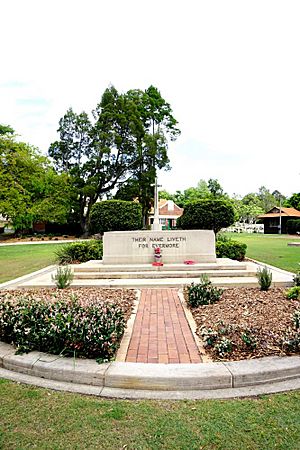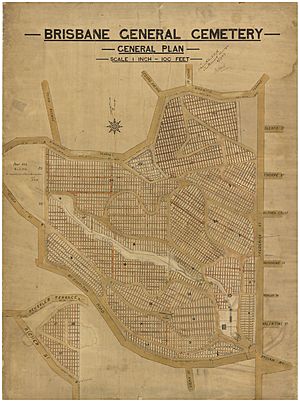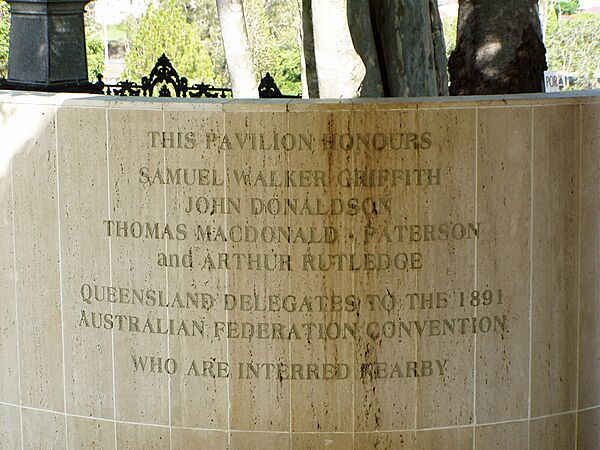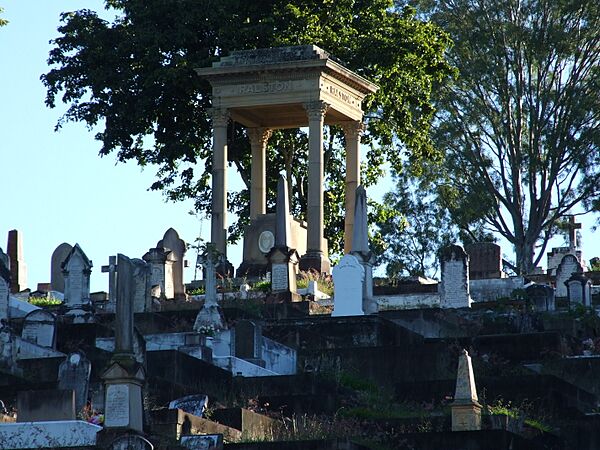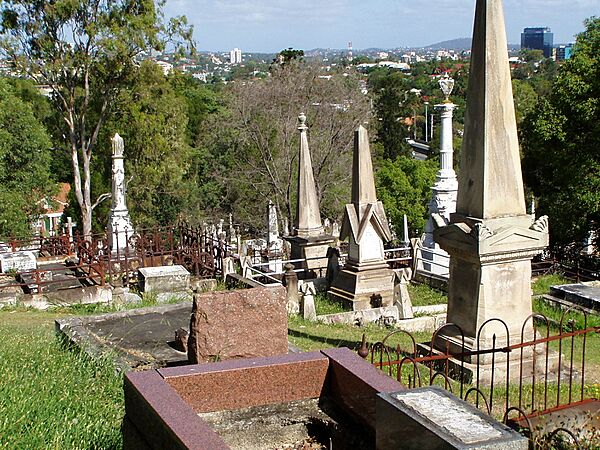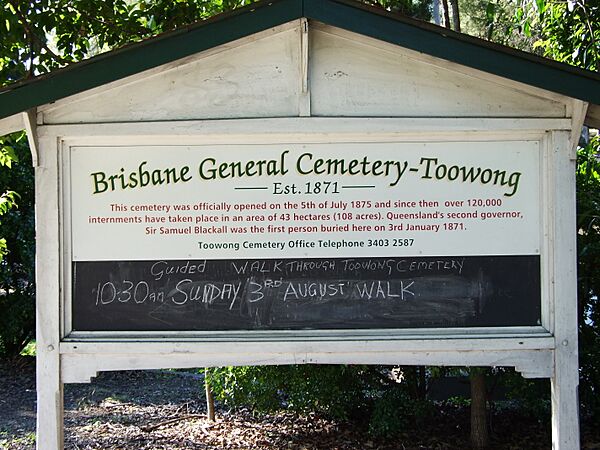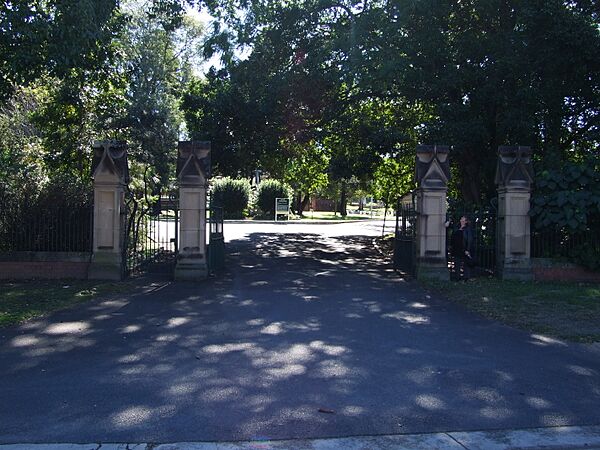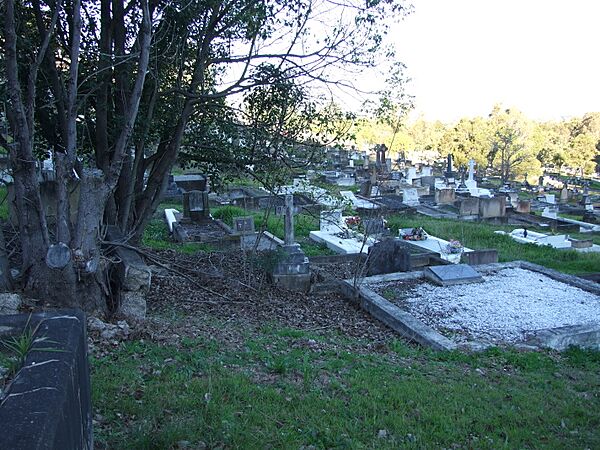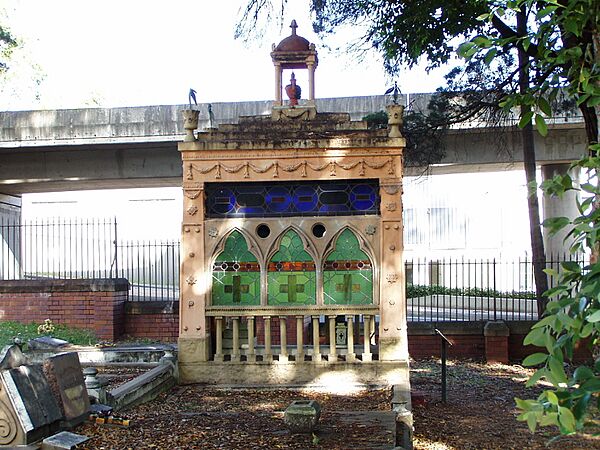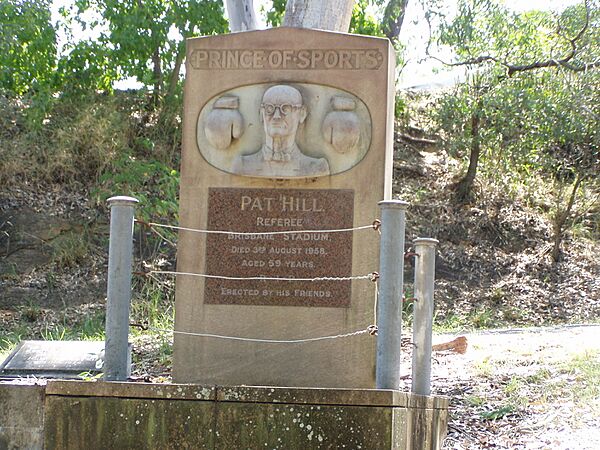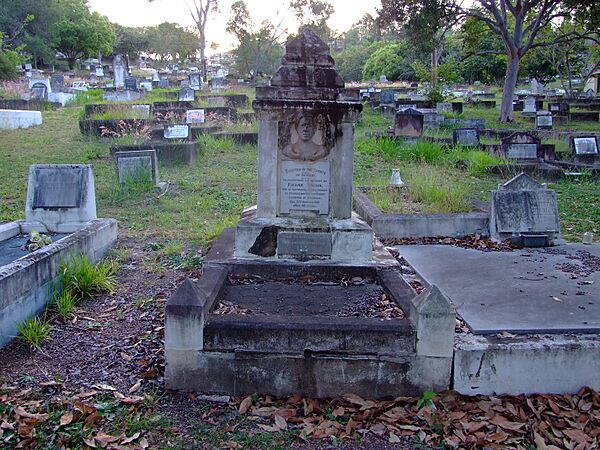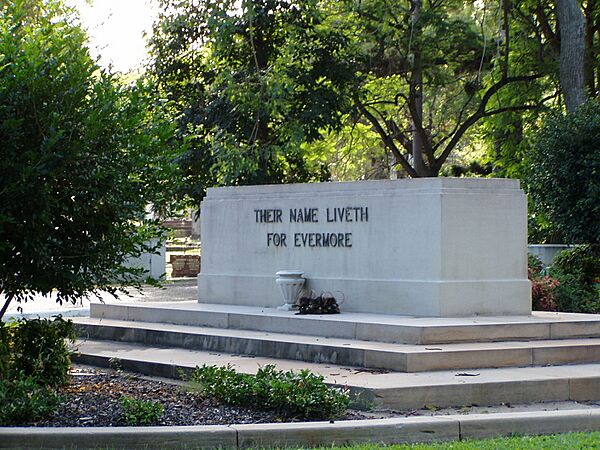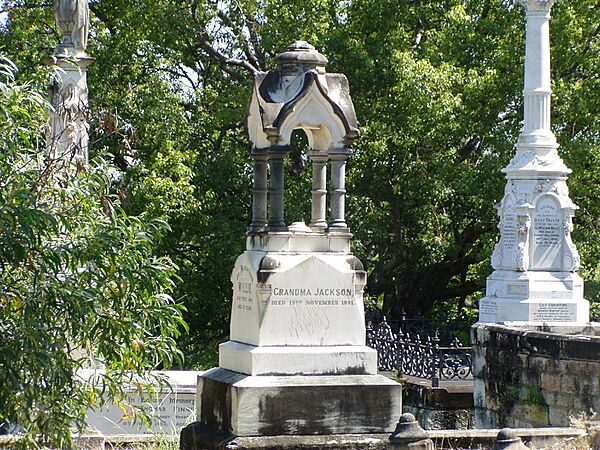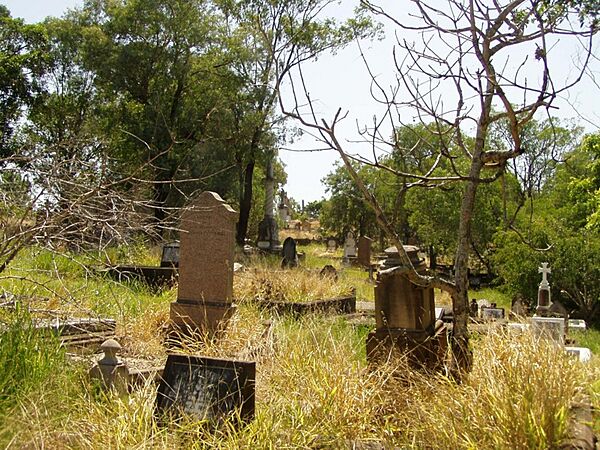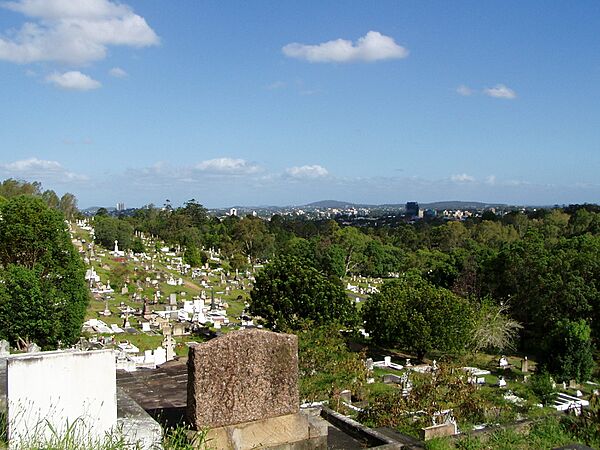Toowong Cemetery facts for kids
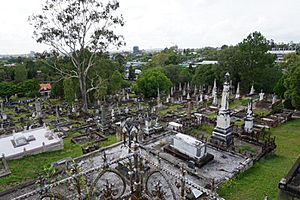
Toowong Cemetery, looking towards the south-east, 2015
|
|
| Details | |
|---|---|
| Established | 1866 |
| Location |
Toowong, Brisbane
|
| Country | Australia |
| Type | Monumental |
| Owned by | Brisbane City Council |
| Size | 44 hectares |
| No. of graves | Over 120,000 |
| Toowong Cemetery | |
|---|---|
| Lua error in Module:Location_map at line 420: attempt to index field 'wikibase' (a nil value). | |
| Location | Corner of Frederick Street and Mt Cootha Road, Toowong, City of Brisbane, Queensland, Australia |
| Design period | 1870s–1890s (late 19th century) |
| Built | 1870 - |
| Official name: Toowong Cemetery, Brisbane General Cemetery | |
| Type | state heritage (built, landscape) |
| Designated | 31 December 2002 |
| Reference no. | 601773 |
| Significant period | 1870- (social) 1870–1998 (historical) 1870–1924 |
| Significant components | gate - entrance, memorial - cairn, sexton's office, cemetery, grave marker, fence/wall - perimeter, memorial - plaque, headstone, trees/plantings, road/roadway, pathway/walkway, shed - shelter, amenities building |
The Toowong Cemetery is a very old and important cemetery in Toowong, Brisbane, Queensland, Australia. It was started in 1866 and officially opened in 1875. It is the largest cemetery in Queensland, covering 44 hectares (about 108 acres). You can find it at the corner of Frederick Street and Mount Coot-tha Road, about four and a half kilometres west of Brisbane city. It used to be called the Brisbane General Cemetery. This place is so important that it was added to the Queensland Heritage Register in 2002.
Even though it's still used for burials, Toowong Cemetery is also a popular spot for people to exercise. Many people go there for jogging or walking their dogs. It has beautiful old fig trees and winding paths. A group called the Friends of Toowong Cemetery offers tours. They also have self-guided walks you can do on your own. If you're brave, you can even go on guided "ghost tours" at night!
Contents
A Look Back: Toowong Cemetery's Story
The story of Toowong Cemetery is quite interesting, with some delays and disagreements along the way. It took many years to set up a new main cemetery for Brisbane in the 1800s.
Early Burial Grounds in Brisbane
The very first cemetery in Brisbane was for the small prison settlement between 1825 and 1842. It was near the William Jolly Bridge today. Soldiers and prisoners were buried there. But it was not thought suitable for children.
As Brisbane grew after 1842, the cemetery became surrounded by homes. People wanted cemeteries to be outside of town. A new burial ground was planned in 1844, further west. It was known as the North Brisbane Burial Ground, or sometimes Milton or Paddington Cemetery. But people still felt it was too close to homes. They worried about their health.
Choosing the Toowong Site
In 1861, a large piece of land (about 200 acres) was set aside for a cemetery at Toowong. This was about 2 miles from the North Brisbane Burial Ground. The Surveyor-General, Augustus Gregory, didn't really like the Toowong site. But he said it was the only place that met the needs.
For the next 20 years, people argued about whether Toowong was the right place. It was far away and hard to get to. Many people kept using the older, closer cemetery at Paddington because it was cheaper and easier.
Official Opening and First Burials
Even though a law was passed in 1866 to create general cemeteries, Toowong Cemetery didn't officially open until 1875.
In 1871, Samuel Wensley Blackall, Queensland's second governor, became very ill. He wanted to be buried at Toowong. He was buried there on January 3, 1871. His memorial is the largest and most noticeable in the cemetery. It offers amazing views of the city.
Even after Governor Blackall's burial, the people in charge still looked for other sites. But they couldn't agree on a price for other land. So, the Toowong site was finally accepted as the Brisbane General Cemetery.
In 1872, some land was cleared and fenced. A Keeper's Lodge was built in 1873-74. The main entrance gates were designed by the Colonial Architect, FDG Stanley.
Before the official opening, six people were buried there. The first was Ann Hill in November 1871.
Different Sections for Different Groups
The cemetery trustees received many requests for separate burial areas. Different churches and groups wanted their own sections. This was to keep social and religious differences even after death.
- Portion 1 was for the Church of England.
- Portion 2 was for Wesleyans.
- Portion 3 was for Jewish people.
- Portion 7 was for Roman Catholics.
- Portion 15 was for criminals (later resold).
- Portion 16 was for people who couldn't afford a burial.
- The Chinese community was moved several times before settling in Portion 19. Many Chinese graves were later dug up and moved back to China.
The winding roads helped separate these different groups. The Christian sections are very large, showing that most people in Brisbane were Anglo-Saxon Christians.
Getting to the Cemetery
One problem with the Toowong site was that it was hard to get to for funerals. But in 1875, the railway line was extended to Toowong. This helped a lot. The cemetery was officially opened on July 5, 1875.
There were still some arguments about the cemetery. In 1877, a government inquiry looked into health worries, the hilly land, and how hard it was for mourners to get there. But the cemetery stayed open.
A Place for Recreation and Beauty
Over time, Toowong Cemetery became valued not just as a burial place. It was also seen as a place for recreation and peace. The trustees wanted it to be kept beautiful, like a park, for the people of Brisbane to visit.
Concerns about health risks from the cemetery lessened in the 1880s. In fact, in 1886, a road was approved to go through the cemetery.
The cemetery was already full of trees by then. From 1876, many plants and young trees were brought from the Botanical Gardens. Walter Hill, the Botanical Gardens superintendent, even donated 38 shade trees.
From 1878, a gardener named William Melville looked after the cemetery gardens for 38 years. Flowers and plants were grown on site and sold to visitors.
Changes Over the Years
In 1886, the Defence Force used a part of the cemetery land as a rifle range. This area is now Anzac Park.
In 1891, the Toowong Shire Council wanted to use some of the cemetery land for public recreation. The trustees eventually agreed. In 1915, a law was passed to transfer 132 acres to the Toowong Town Council for a park. The money from this sale was used to build new gates and fences.
Public transport finally reached the cemetery in 1901 when the tramway was extended. A tram shelter was built in 1916.
In 1911, a law allowed the Queensland Government to move graves from the old Milton cemeteries. If families requested it, remains and memorials were moved. About 139 remains and 105 memorials were moved from Milton to Toowong. Many of these are in Portion 6.
From 1920 to 1930, Canon David John Garland led Brisbane's main ANZAC Day ceremonies at Toowong Cemetery. He is often called the "architect of Anzac Day." In 1924, thanks to his fundraising, a Stone of Remembrance and Cross of Sacrifice were placed in the cemetery. In 1930, Anzac Day services moved to ANZAC Square in the city. Canon Garland was buried in Toowong Cemetery in 1939.
In 1930, the Brisbane City Council took over managing Toowong Cemetery. A part of the cemetery land was later used by the Australian Military Forces for training. It then became a Bus Depot.
Flowers were grown and sold at the cemetery until the 1930s. In 1934, the area for soldier's graves was expanded, taking over the flower gardens. By April 1975, all burial plots were sold. The cemetery was closed, except for burials in existing family graves.
In the early 1980s, some footpaths and the old tram shelter were removed due to road construction. This made it harder to get to the main gates.
The old Sexton's office, built around 1900, was no longer used after a new one was built in 1989. In 1991, it was restored and turned into a museum. Also in 1991, the Toowong Cemetery Heritage Trail was created. This helps people learn about the cemetery's history.
In 1992, steel gates were put up at some entrances to stop vandalism and drag racing. The same year, volunteers formed The Friends of Toowong Cemetery. They help look after neglected graves and give tours.
The cemetery reopened in 1998, with about 450 new plots available for sale.
In 2010, plans for a tunnel (now called Legacy Way) under the cemetery raised worries about vibrations damaging memorials. In 2012, conservation work was done on 44 memorials to protect them from the tunnel boring.
In 2013, the Canon Garland Memorial Society was formed. In 2015, the Brisbane City Council opened Canon Garland Place at the cemetery. This lawn garden has an information board and is where Garland held his Anzac Day services.
What Toowong Cemetery Looks Like
Toowong Cemetery is about 4.5 kilometres west of Brisbane city. It covers a large area of 43.73 hectares (about 108 acres). Public roads surround it on all sides. The land is hilly and uneven. A creek runs through the cemetery from the north-west to the south-east.
The main entrance is at the south-east corner, on Milton Road and Frederick Street. It has a semi-circular gateway with stone posts and a cast iron fence. This was built around 1915. The fence continues along Frederick Street for some distance. Other entrances on Richter Street and Frederick Street have modern boom gates. The cemetery is open from 6 am to 6 pm.
The cemetery is on high ground, giving great views of Brisbane city. It is divided by winding bitumen roads. Between these roads are areas for burials, laid out in different shapes and directions.
Layout and Sections
The cemetery's hilly landscape shows how society was divided. Important private graves are on the highest ground in each section. Public graves are in lower areas. The lowest, often wet, ground along the creek was for people who couldn't afford a burial. The grand memorials on high ground show a big difference from the simple, unmarked graves in lower areas.
The creek generally separates the main burial ground to the south from the religious sections to the north.
- Portion 1: Church of England graves, including stillborn babies.
- Portion 2: Originally for Wesleyan Methodists, also has over 10,000 graves of stillborn babies and hospital burials.
- Portion 3: Jewish Section.
- Portion 4: A general area, home to the Temple of Peace and the Caskey Memorial.
- Portion 6: Primitive Methodists and many graves moved from the old Milton/Paddington Cemetery.
- Portion 7 and 7A: Irish and Roman Catholics.
- Portion 8 and 18: General ground, with Greek and Russian Orthodox graves at the western ends.
- Portion 19: Where the Chinese graves were eventually moved.
- Portions 9, 11, 12, 13, and 14: Surround the Blackall Monument. The upper parts of these sections hold the graves of many important Queensland figures.
- Portion 10: Contains the cemetery's buildings. The Stone of Remembrance and Cross of Sacrifice are at the southern end.
- Portion 30: The last area laid out in 1930. It includes graves for patients from old asylums.
The graves are laid out in different directions, some facing magnetic north, some true north, and others at various angles.
Trees and Landscaping
At the cemetery entrance, there are impressive large trees like Weeping Banyan, Camphor Laurels, and Bangalow Palms. A line of Cypress Pines behind the Cross of Sacrifice hides the Amenities Building. Large fig trees mark many road crossings. Other trees like Bunya Pines, Jacaranda, and Eucalypts give the whole site a natural look.
There are also small avenues of trees, like Camphor Laurels between portions 6 and 9. Another avenue of trees leads to the Blackall Monument, creating a special feeling as you approach it. A huge banyan fig tree and a maple tree stand behind the monument.
Memorials and Buildings
There are about 117,000 people buried at Toowong. The headstones and memorials are very diverse. The tall Blackall Memorial is the most dominant feature in the southern part of the cemetery. You can see it from far away along the Western Freeway. Many individual graves show amazing craftsmanship, with sculptures, tiles, ironwork, and plants.
The buildings for managing the cemetery are mostly in Portion 10. The Museum building, which used to be the Sexton's office, was built around 1900. It's a timber building with a terracotta tile roof. It sits over an old drain where a flower shed used to be.
The 1924 Amenities Building is a well-preserved brick building with a terracotta tile roof. It has a symmetrical design with rest areas, toilets, and retiring rooms.
Other buildings in Portion 10 include the new Sexton's office, built in 1989, and a storage shed.
Why Toowong Cemetery is Important
Toowong Cemetery was added to the Queensland Heritage Register in 2002 because it meets several important criteria.
Showing Queensland's History
This cemetery is Queensland's largest. It shows how Brisbane's history has changed. The different sections and memorials tell us about the city's population, its many cultures, religions, and ethnic groups. The way the burial sites are laid out shows the social and religious divisions of the 1800s. The changing styles of memorials also show how attitudes towards death and funeral decorations have changed since the 1870s.
Unique Cultural Heritage
Toowong Cemetery is a rare example of a "mortuary park" from the Victorian era. The collection of memorials and gravestones holds unique information. This is valuable for people studying art, military history, local history, architecture, and even family trees.
Learning About the Past
The cemetery's layout and buildings, like the old Sexton's office, can help us learn more about burial practices in the 19th and 20th centuries.
A Great Example of a Cemetery
Located near Mt Coot-tha, the Botanical Gardens, and Anzac Park, Toowong Cemetery looks like the "mortuary parks" that Victorians imagined. Its high location helped reduce health risks, and it included all religious groups. These are typical features of large cemeteries from the late 1800s.
Beautiful and Peaceful
The cemetery has a special beauty, with its fences, gates, shelters, memorials, and landscaping. This creates a peaceful atmosphere that helps people remember and honour the dead. This feeling is still valued by the community today.
Amazing Design and Craftsmanship
Many memorials show high levels of creativity and skill. They are important for their excellent design, beautiful materials, and dramatic appearance. The Temple of Peace, Trooper Cobb's Grave, and the Caskey Memorial are so important they are listed separately on heritage registers. The memorial to Governor Blackall is a tall, impressive stone column. It's a landmark that stands out in the southern part of the cemetery. Together, all the memorials, big and small, are even more impressive because of their variety and location.
Important to the Community
As Brisbane's main public cemetery, Toowong Cemetery has always been a place for public ceremonies and feelings. It continues to be important to the Brisbane community. People from all walks of life are buried here. It has a special connection to many important people in Queensland's history. This includes a Prime Minister, two Queensland Governors, 13 Queensland Premiers, and many other significant political, religious, sports, arts, and business figures.
Connected to Important People
The cemetery has a strong link to Governor Samuel Wensley Blackall. The prominent spot chosen for his huge monument shows how respected and popular he was. The cemetery is also connected to its trustees, who were in charge of its development. Many of them are buried there. For example, James Cowlishaw, an architect, was a trustee for 59 years. John Petrie, a builder and monumental mason, was also a founding trustee. His business, located opposite the cemetery for 100 years, made many of the memorials there. Architect Edward Myer Myers designed the Amenities Building. The monuments also show the work of skilled masons, artists, and craftsmen in Queensland.
Other Heritage Listings
Besides the cemetery itself, some individual monuments within it are also heritage-listed:
- Caskey Monument (listed in 1992)
- Temple of Peace (listed in 1992)
- Trooper Cobb's Grave (listed in 1992)
War Graves
The cemetery contains the graves of 270 Commonwealth service members from World War I and 117 from World War II. There are also two Dutch Navy sailors from World War II. Most of these graves are in the Returned Services Plot in Portion 10.
Images for kids


